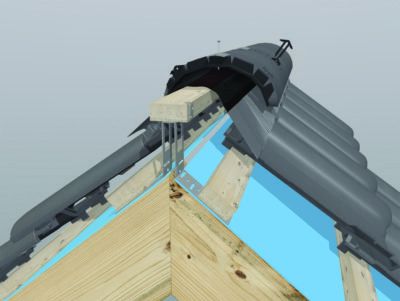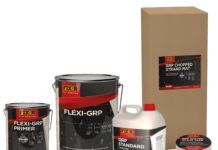 When it comes to fixing ridges, hips and verges, the days of mixing, carrying and using traditional sand or cement mortar bedding may well be a thing of the past. Following changes to BS 5534:2014, and the increasing frequency and ferocity of stormy weather over recent years, there has been a massive swing towards mechanical fixing or dry-fix roofing that requires no mortar.
When it comes to fixing ridges, hips and verges, the days of mixing, carrying and using traditional sand or cement mortar bedding may well be a thing of the past. Following changes to BS 5534:2014, and the increasing frequency and ferocity of stormy weather over recent years, there has been a massive swing towards mechanical fixing or dry-fix roofing that requires no mortar.
The benefits of dry-fix roofing versus mortar bedding are well known. The roof is the most exposed part of any building, and using mortar to secure vulnerable areas of the roof, such as the verges, will inevitably lead to future maintenance. Not only can differential movement cause the mortar to crack, frost and rain can then exacerbate the problem by exploiting any hairline cracks.
In contrast, instead of relying solely on mortar for a bond, a dry-fix system typically uses screws – often stainless steel – to attach clamps between the joints of every ridge tile, clamping them to the roof. Beneath these screws are waterproof unions that catch any small amount of direct rainfall and disperse it sideways back onto the roof itself. By mechanically fixing the ridges, hips and verges without mortar, the roof becomes safer and more secure, and offers better resistance to wind uplift and water ingress.
As contractors you are no longer at the mercy of bad weather, for unlike mortar, most dry-fix products can be installed in all weathers and even in damp and frosty conditions. Equally, fixing is fast and simple; no more wasted time going up and down the ladder carrying mortar, and neither are specialist skills or tools required. Dry-fix roofing also provides discrete ventilation of the roof space and helps stop any harmful build-up of condensation.
Consequently, dry-fix roofing can prove highly cost-effective. It also means a more consistent appearance with none of the longer-term maintenance problems and costs associated with mortar bedding.
However, whilst the last update to BS 5534 did much to encourage the use of dry fix products, this is a code of practice and it is not a product standard. It was therefore identified that in order to test – and if necessary improve – the quality of the products on the market, that the time was right to develop one. Whilst dry fix is known to reduce failures formerly associated with mortar, there are still issues in certain areas which needed to be addressed. These include; water discharging down gable end walls where dry verge units are installed, the bottom verge unit disengaging, and some hip and ridge systems becoming disengaged from the roof structure.
To add further clarification to this area of roofing, we understand that development work is well underway at BSI and that a new Product Standard for all dry ridge, hip and verge products is due for publication in the Summer of 2017. It is expected that this forthcoming Standard will reduce any dramatic variations in performance and will provide you with confidence in fully tested products; enabling you to protect your reputation and liability.
However, until this time in the absence of a product standard and given that there is a wealth of dry-fix products already on the market, it can be difficult to ensure that the products you are using are of the highest quality – especially since some suppliers have been quick to capitalise on the tendency to treat all dry-fix products as broadly the same.
In roofing, time is money. Hence, it’s important to only use quality products and efficient processes to avoid unnecessary delays and costly mistakes. Quick fixes can easily backfire, so even when you’re under deadline pressures, it’s always best to use the most appropriate product for the job, first time, every time. By only sourcing dry fixing products from a reputable supplier who will have conducted their own rigorous testing before and during manufacture, you can guarantee confidence in your products.
With dry fix roofing already a very popular means of fixing roof ridges, hips and verges in the UK – and well on course to become the more popular method in the future – it pays to get on board and stay one step ahead of legislation. That way both you and your roof will be home and dry.



